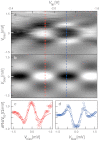Coherent tunnelling across a quantum point contact in the quantum Hall regime
- PMID: 23475303
- PMCID: PMC3593222
- DOI: 10.1038/srep01416
Coherent tunnelling across a quantum point contact in the quantum Hall regime
Abstract
The unique properties of quantum hall devices arise from the ideal one-dimensional edge states that form in a two-dimensional electron system at high magnetic field. Tunnelling between edge states across a quantum point contact (QPC) has already revealed rich physics, like fractionally charged excitations, or chiral Luttinger liquid. Thanks to scanning gate microscopy, we show that a single QPC can turn into an interferometer for specific potential landscapes. Spectroscopy, magnetic field and temperature dependences of electron transport reveal a quantitatively consistent interferometric behavior of the studied QPC. To explain this unexpected behavior, we put forward a new model which relies on the presence of a quantum Hall island at the centre of the constriction as well as on different tunnelling paths surrounding the island, thereby creating a new type of interferometer. This work sets the ground for new device concepts based on coherent tunnelling.
Figures





References
-
- Beenakker C. W. J. & van Houten H. Quantum transport in semiconductor nanostructures. Solid State Physics 44, 1–228 (1991).
-
- Fischer J. & Loss D. Dealing with decoherence. Science 324, 1277–1278 (2009). - PubMed
-
- Roulleau P. et al. Direct measurement of the coherence length of edge states in the Integer quantum Hall regime. Phys. Rev. Lett. 100, 126802 (2008). - PubMed
-
- Huckestein B. Scaling theory of the integer quantum Hall effect. Rev. Mod. Phys. 67, 357–396 (1995).
-
- Ilani S. et al. The microscopic nature of localization in the quantum Hall effect. Nature 427, 328–332 (2004). - PubMed
Publication types
LinkOut - more resources
Full Text Sources
Other Literature Sources

